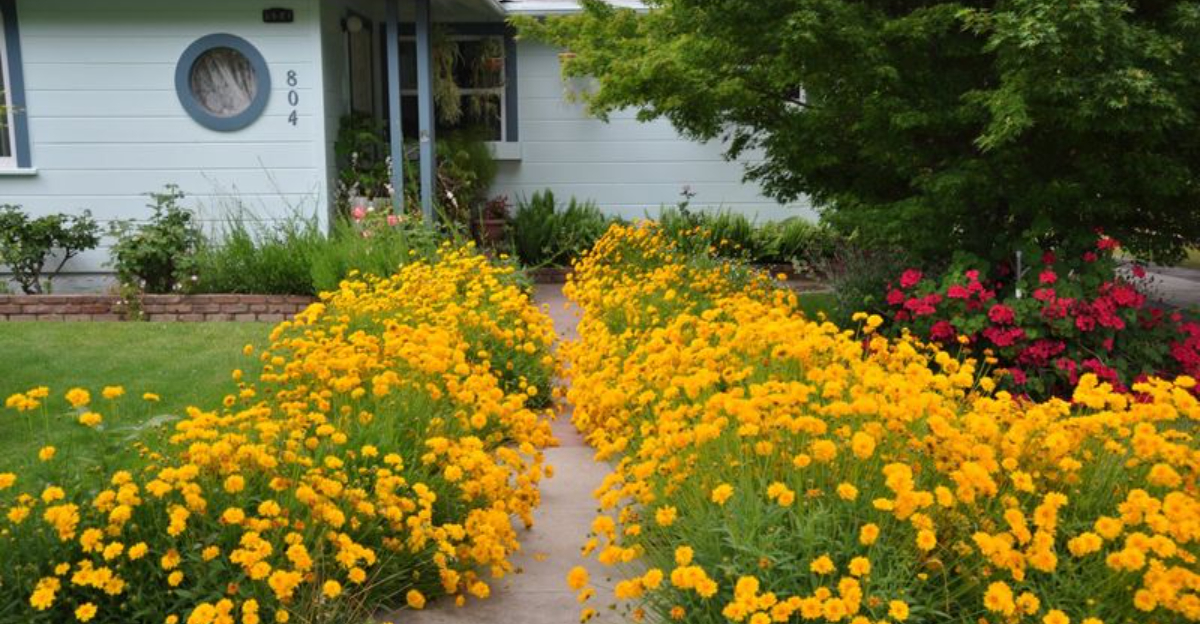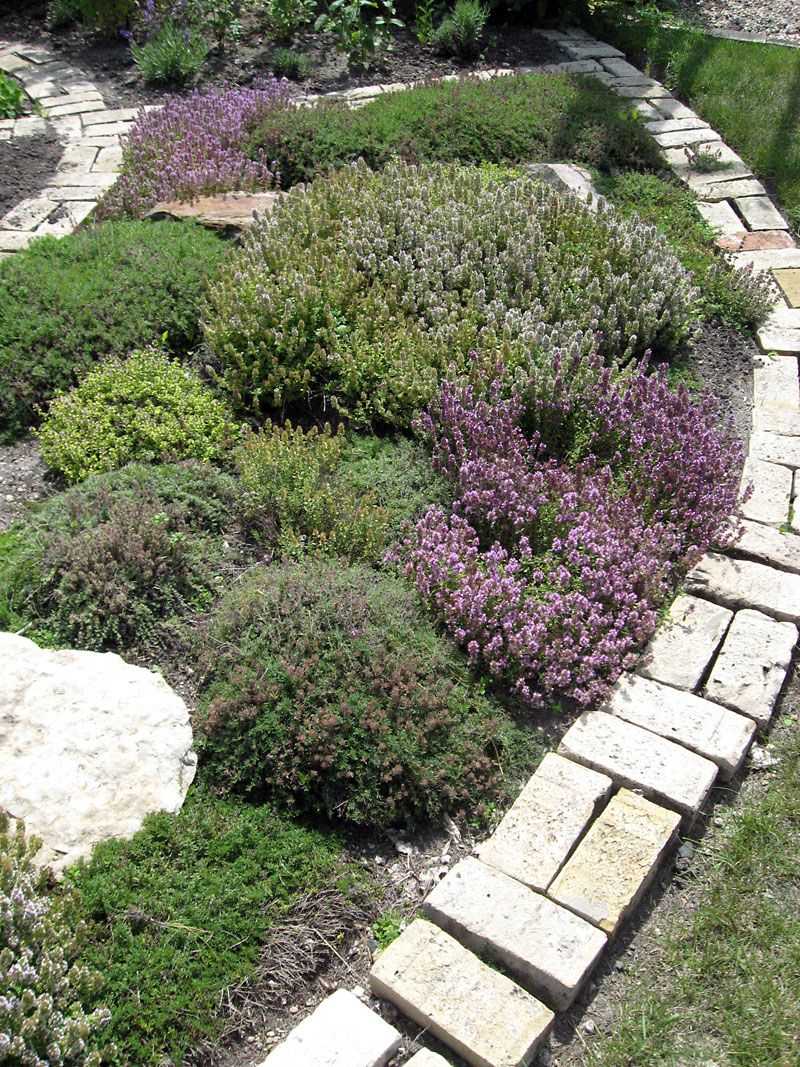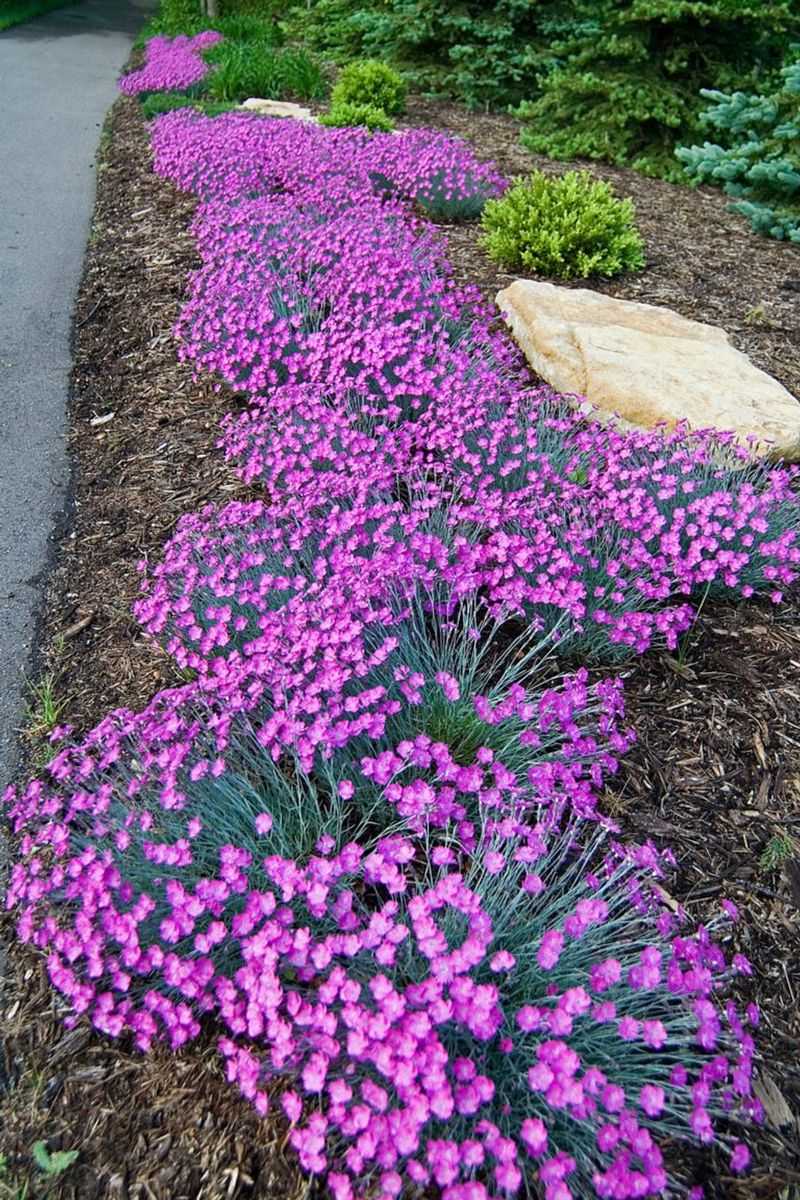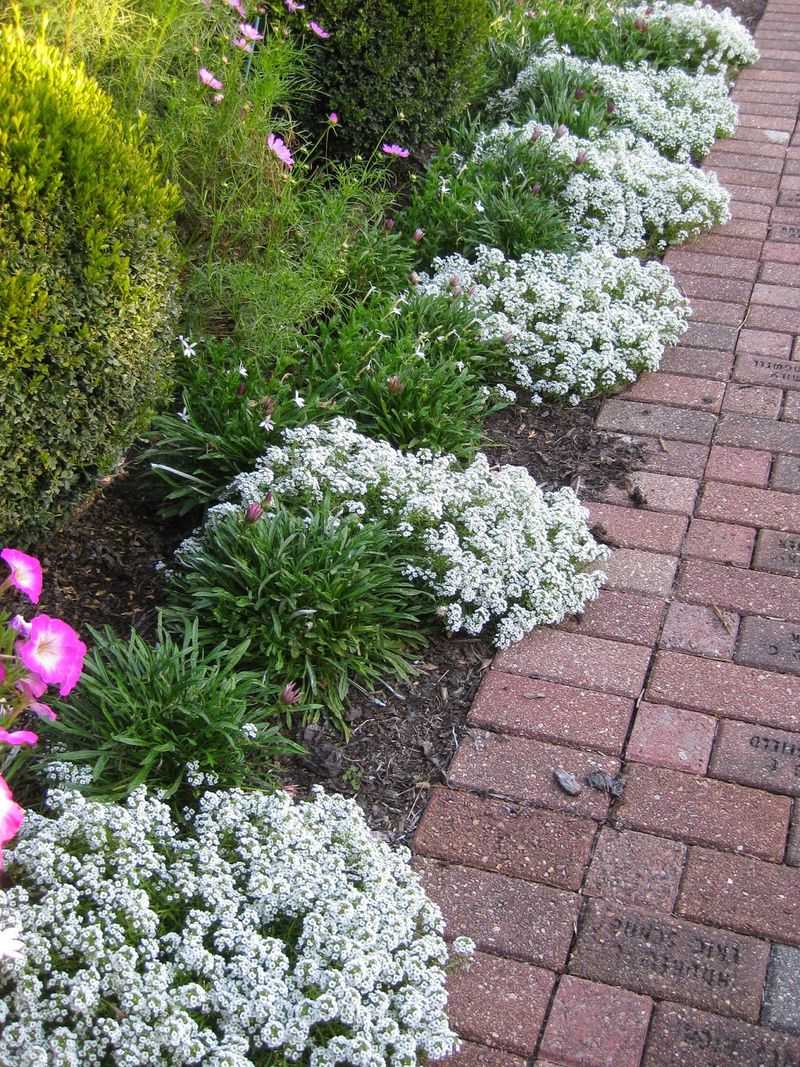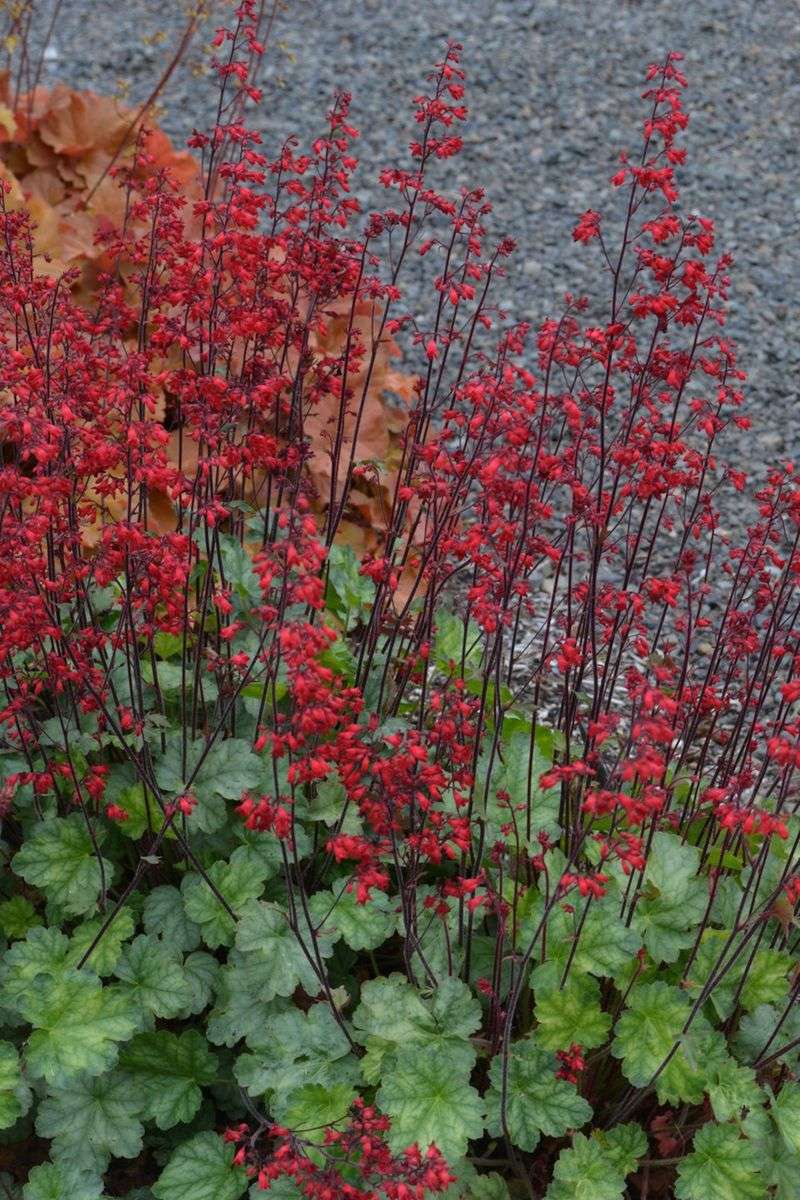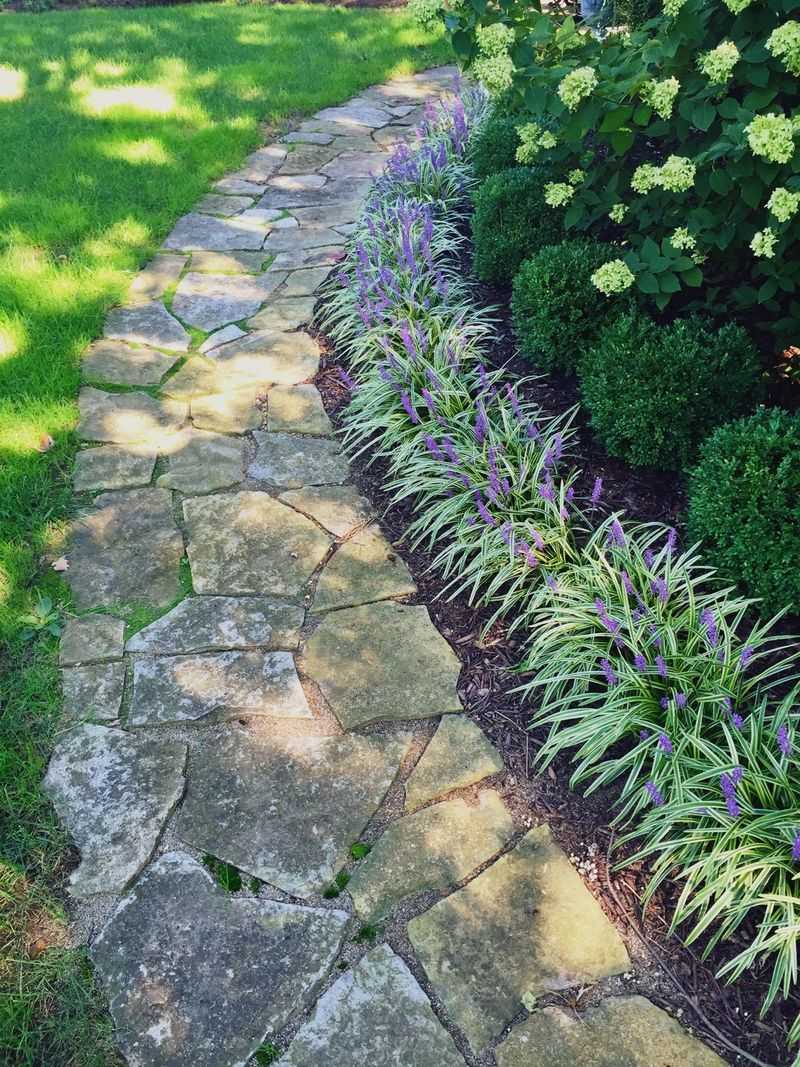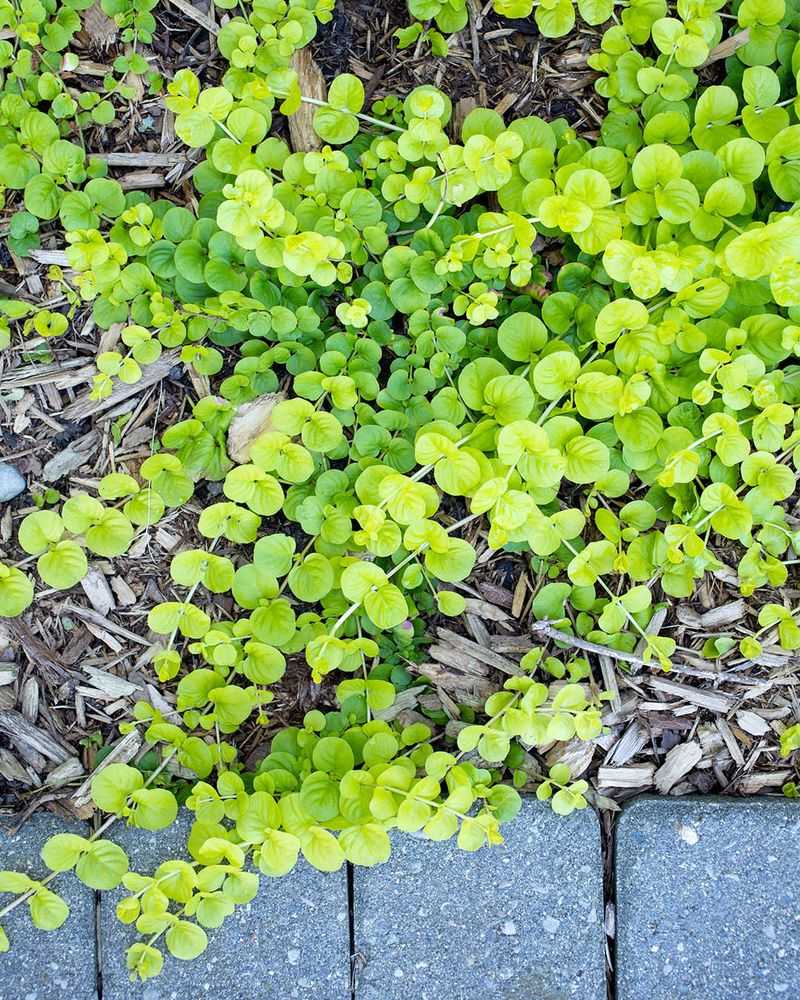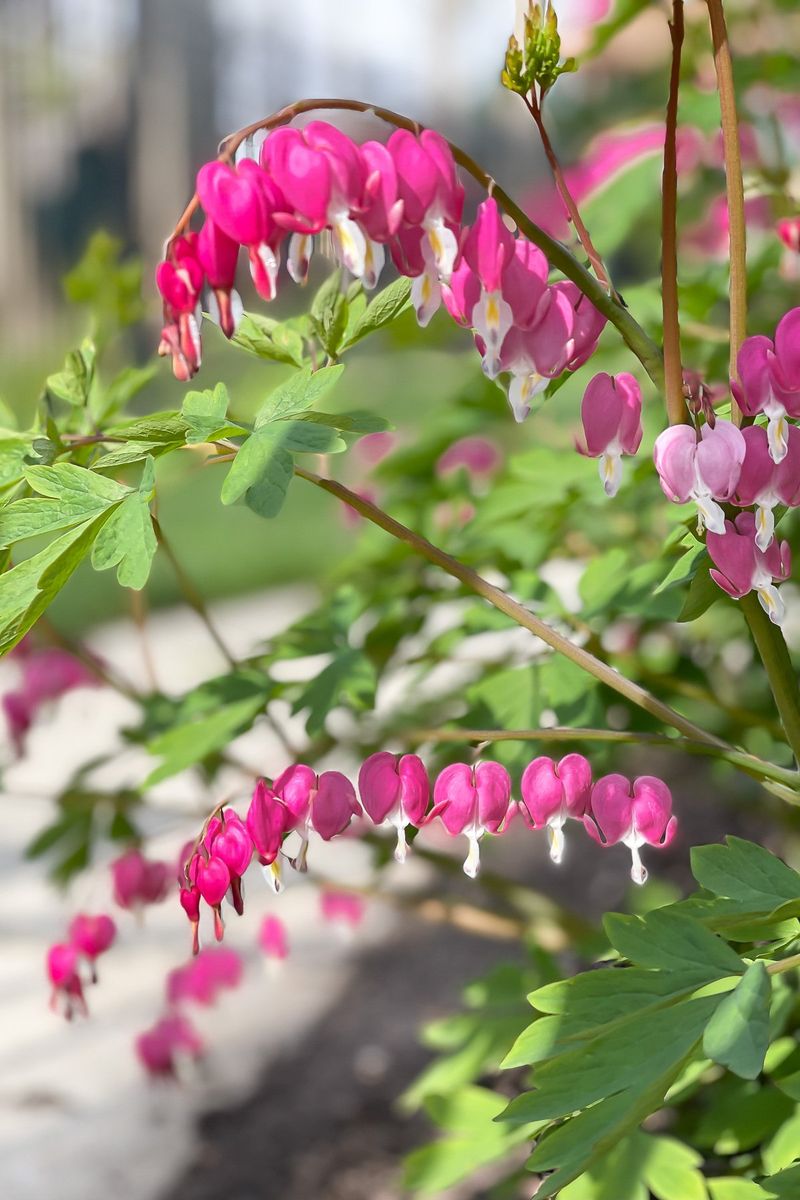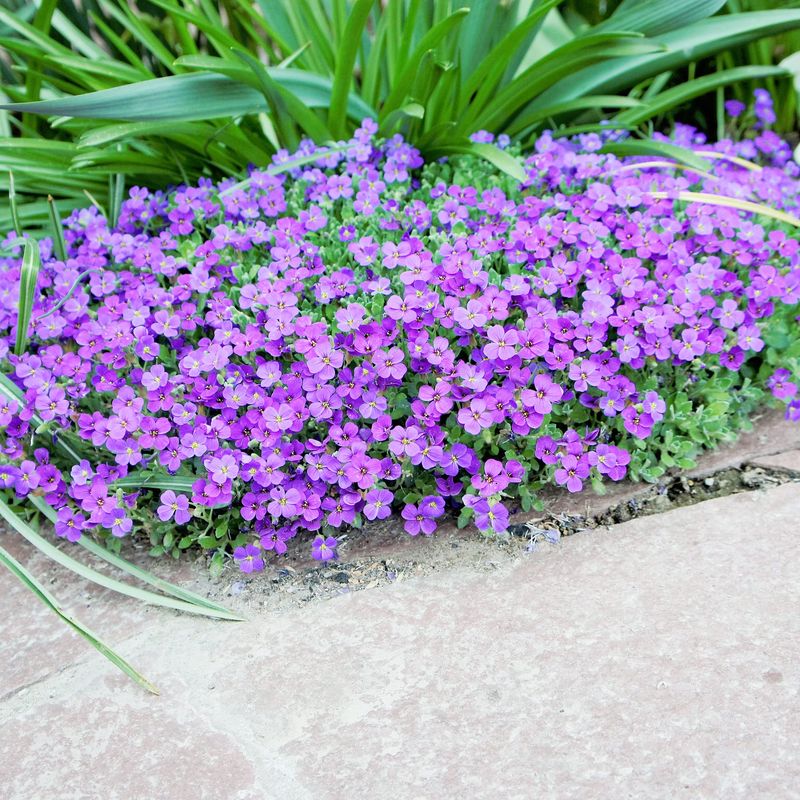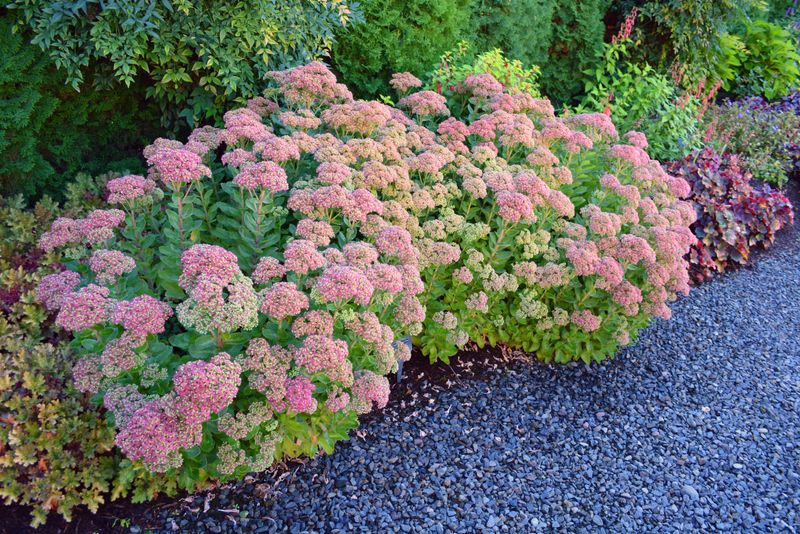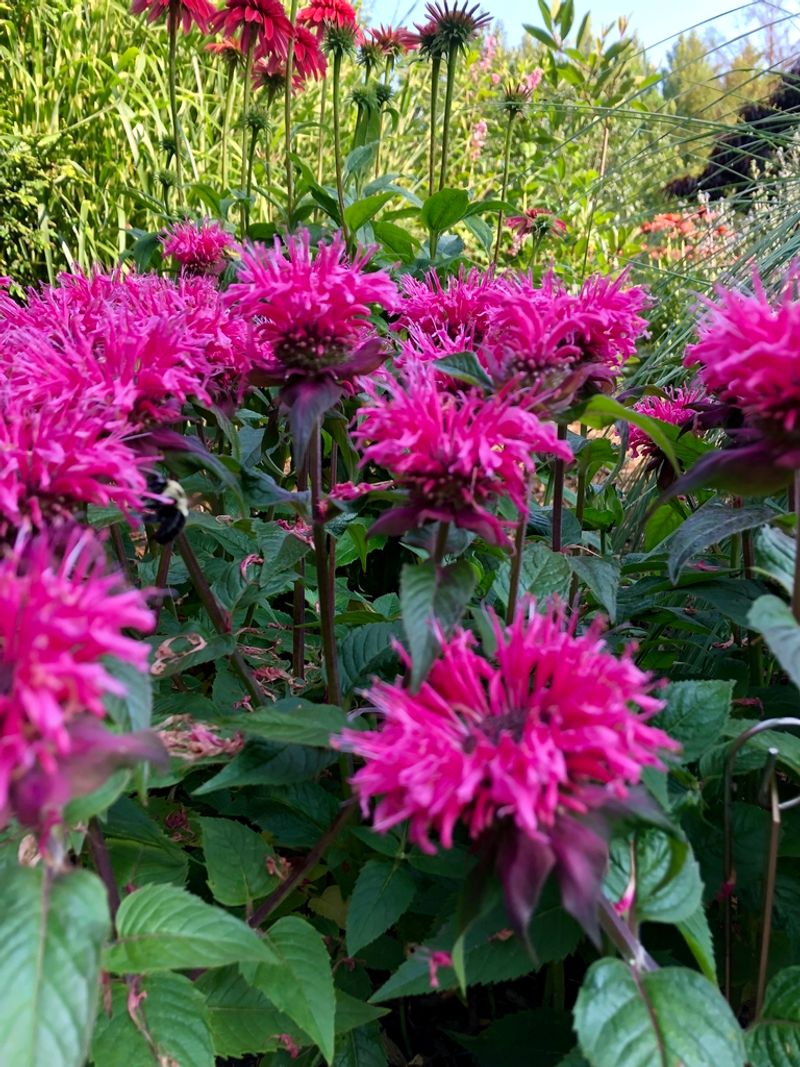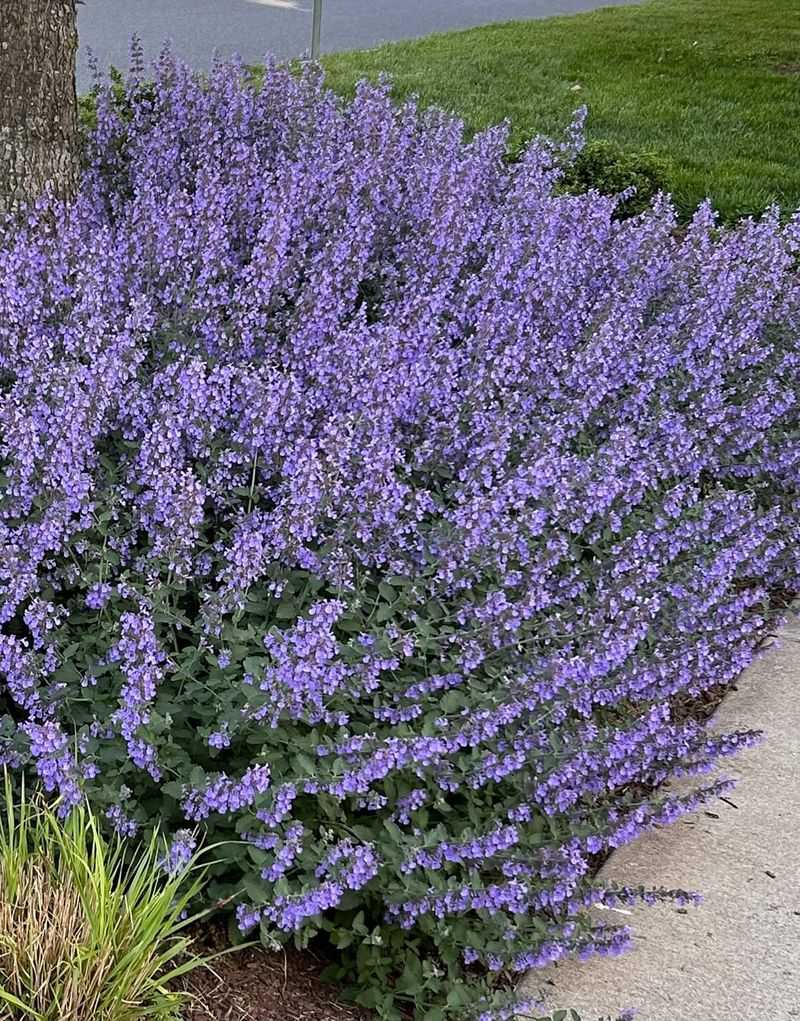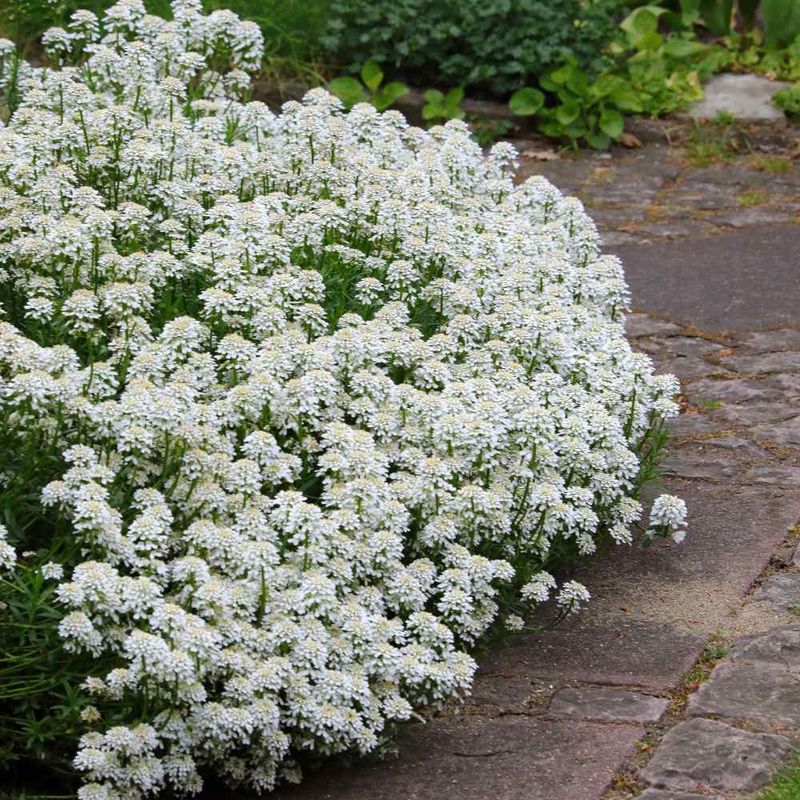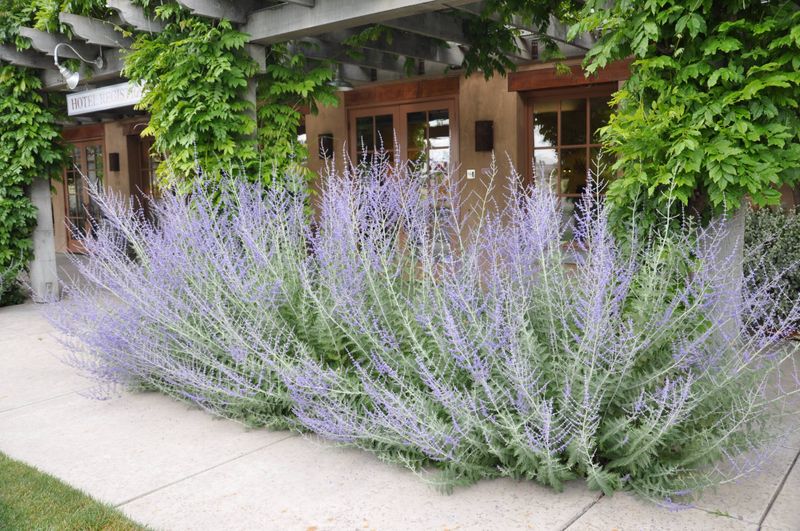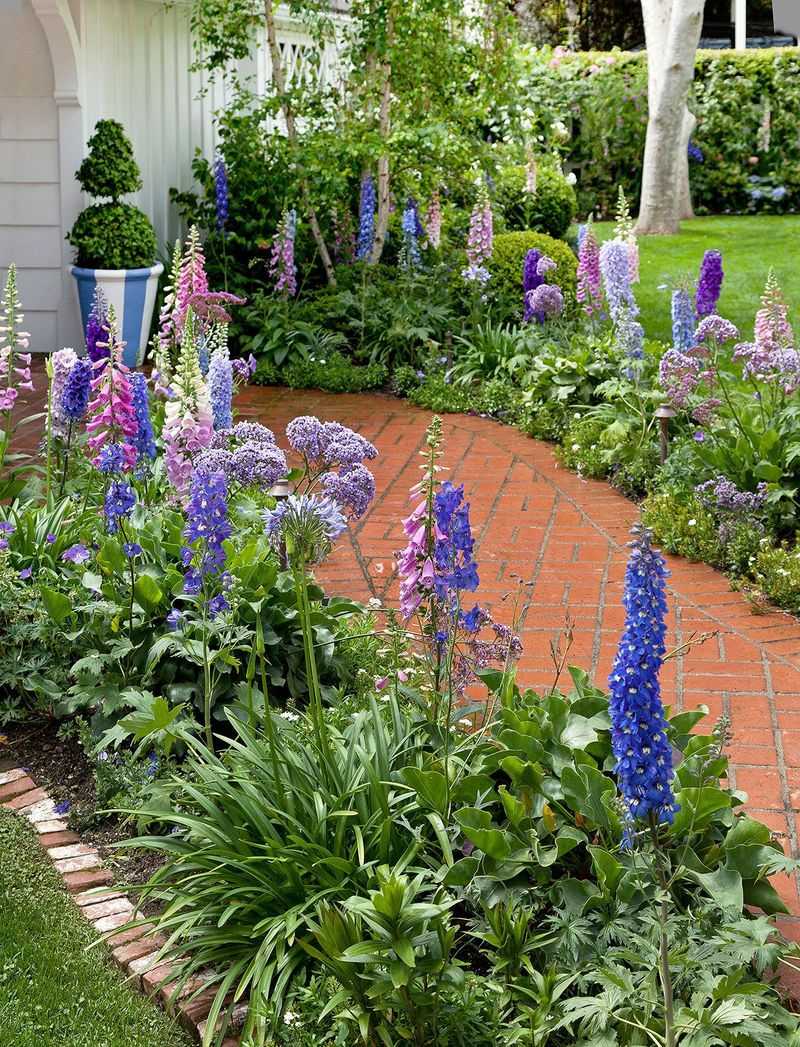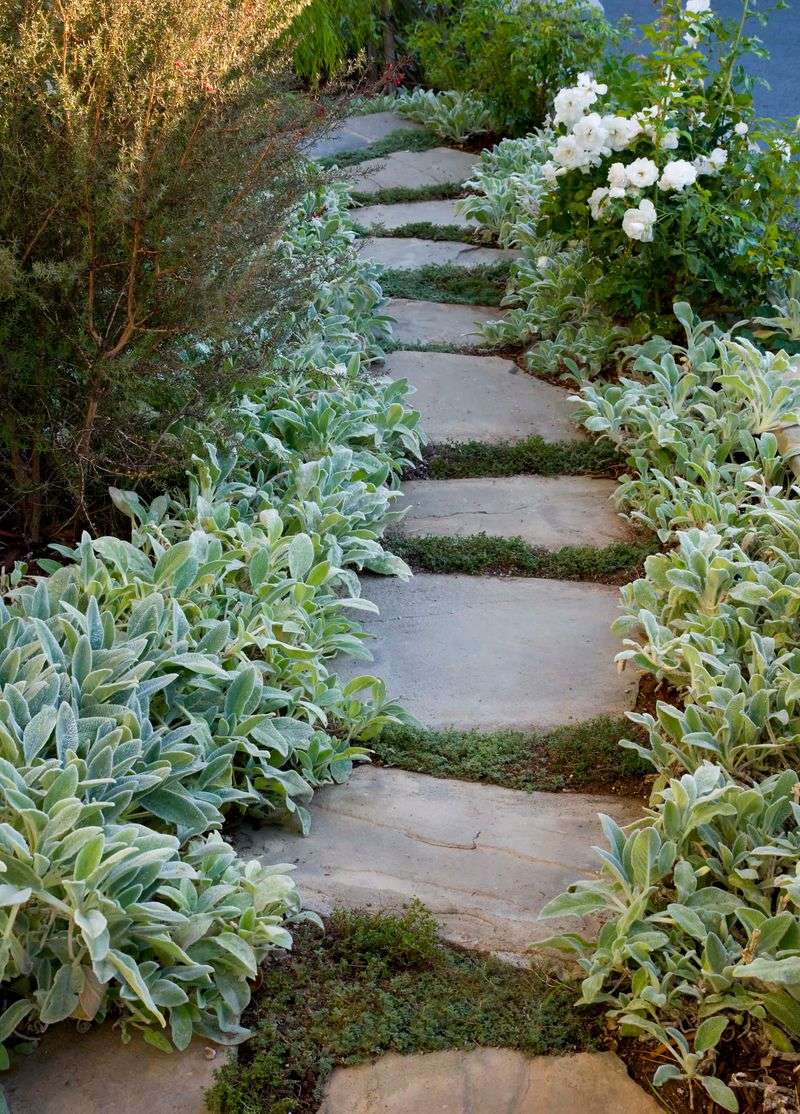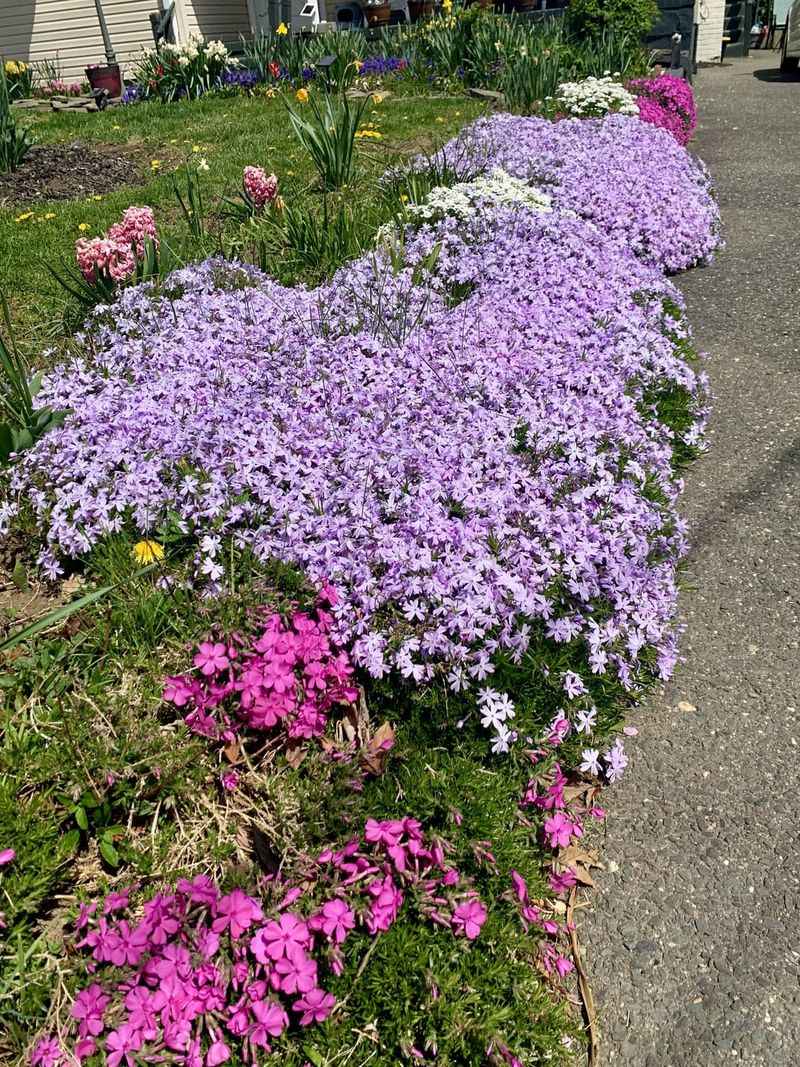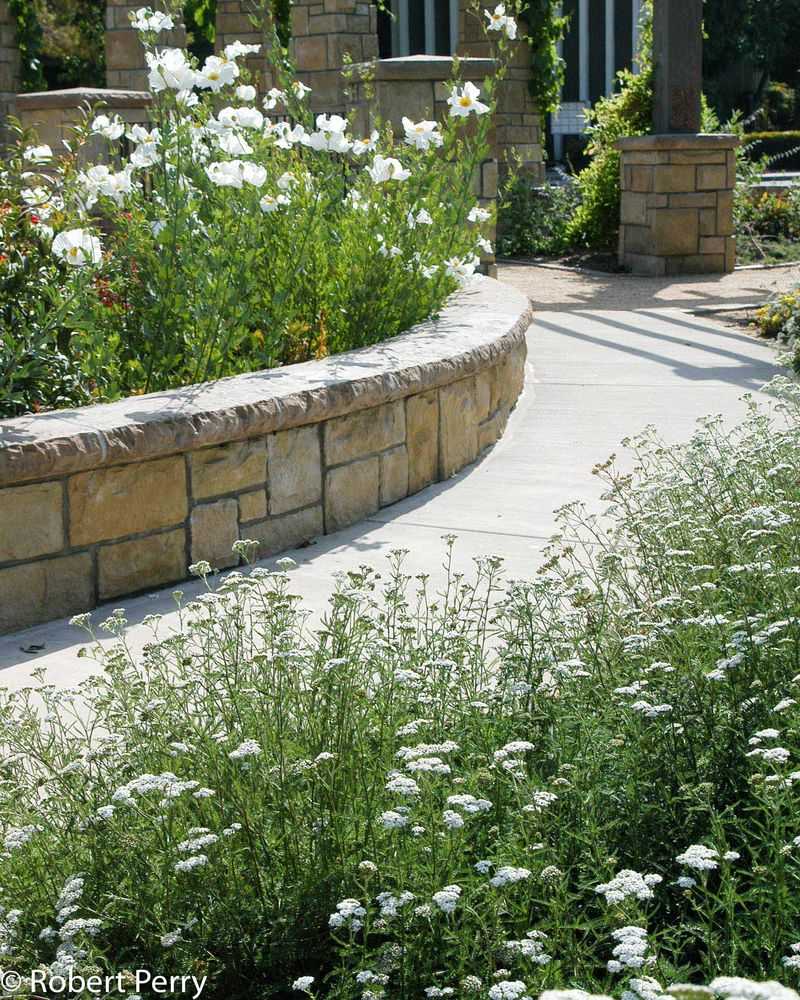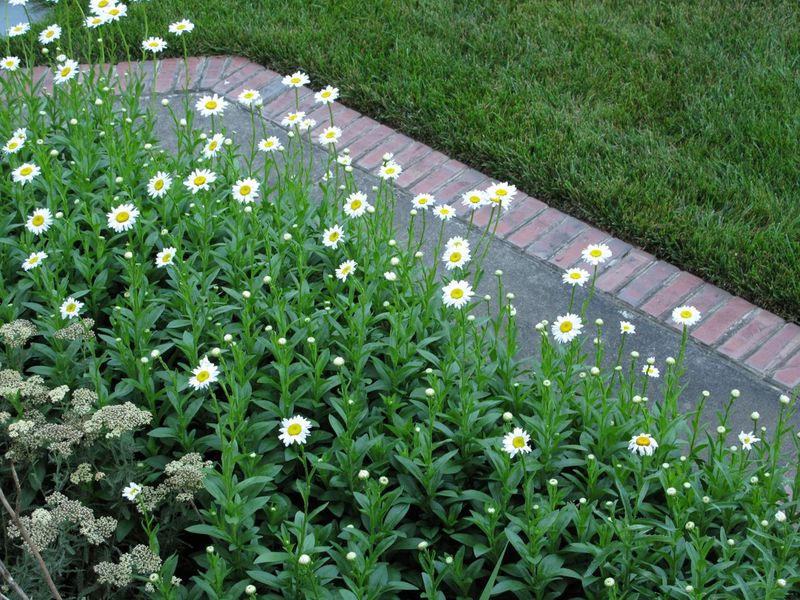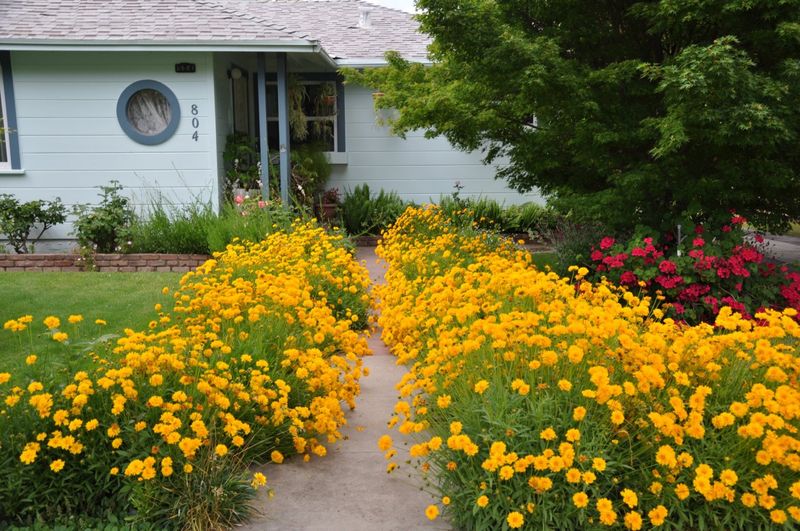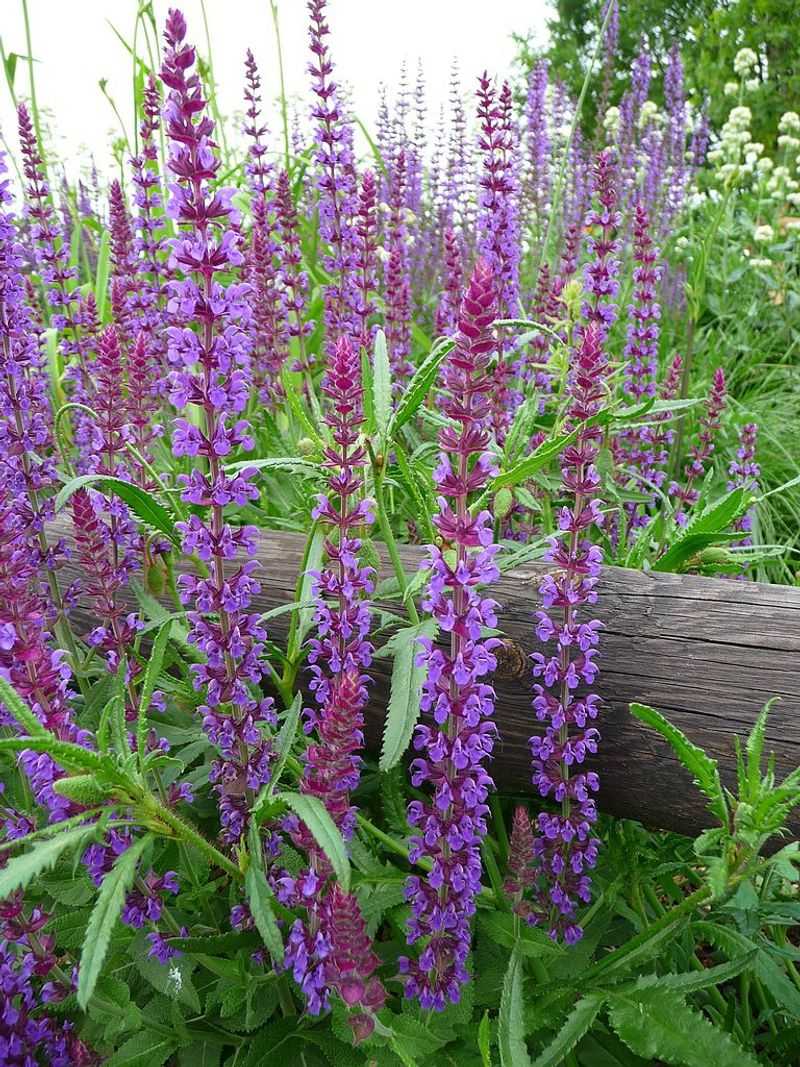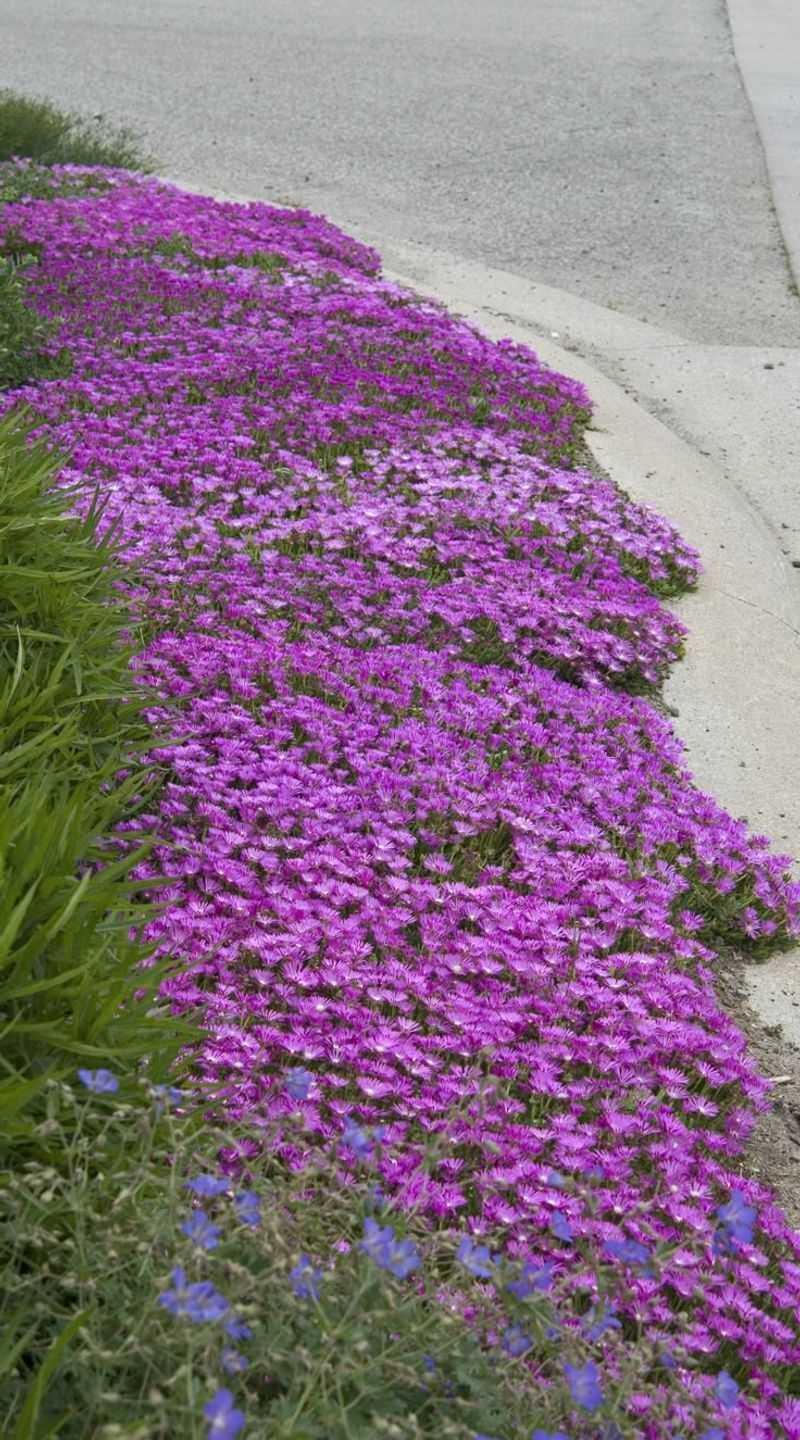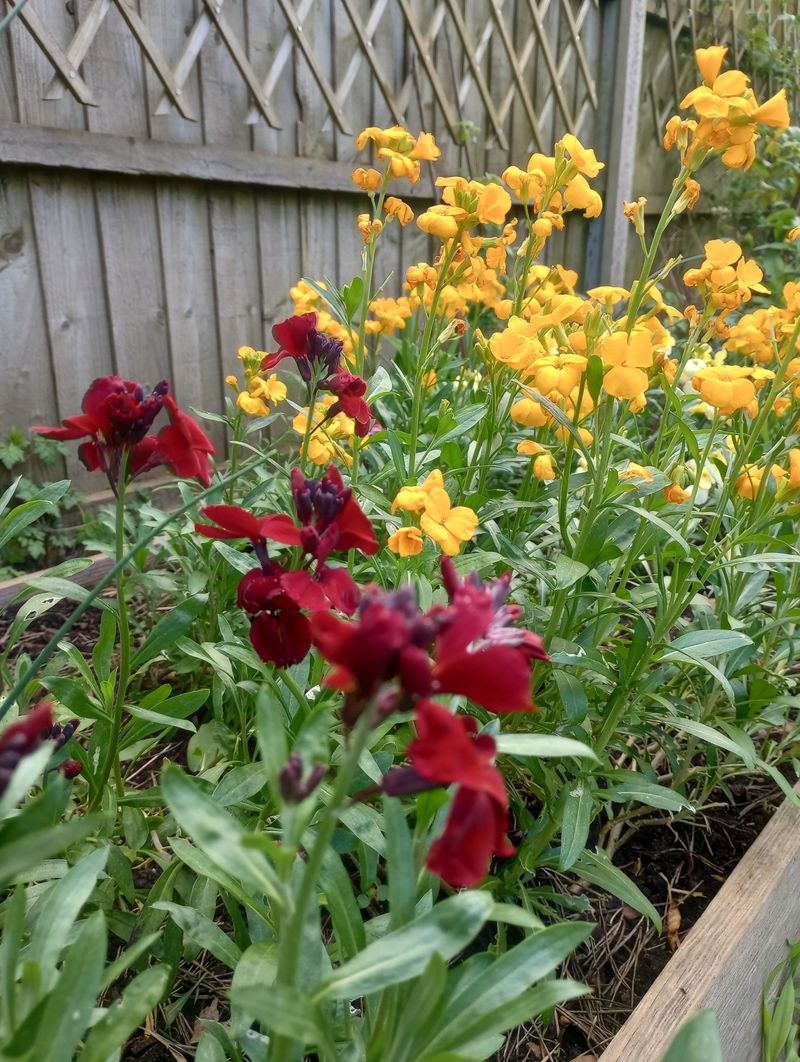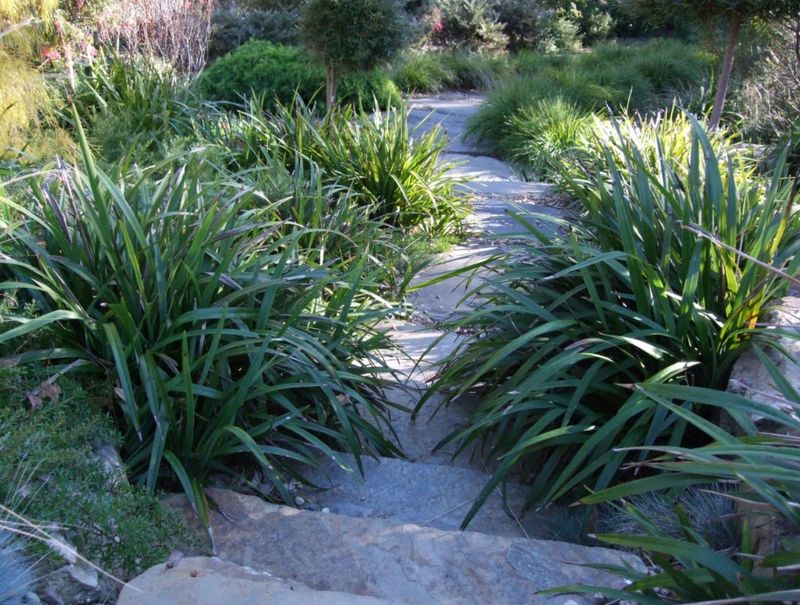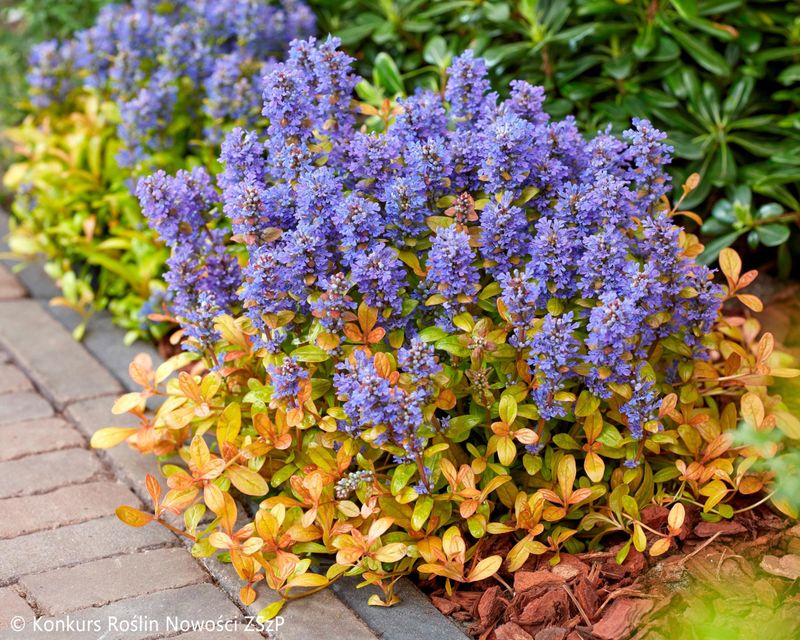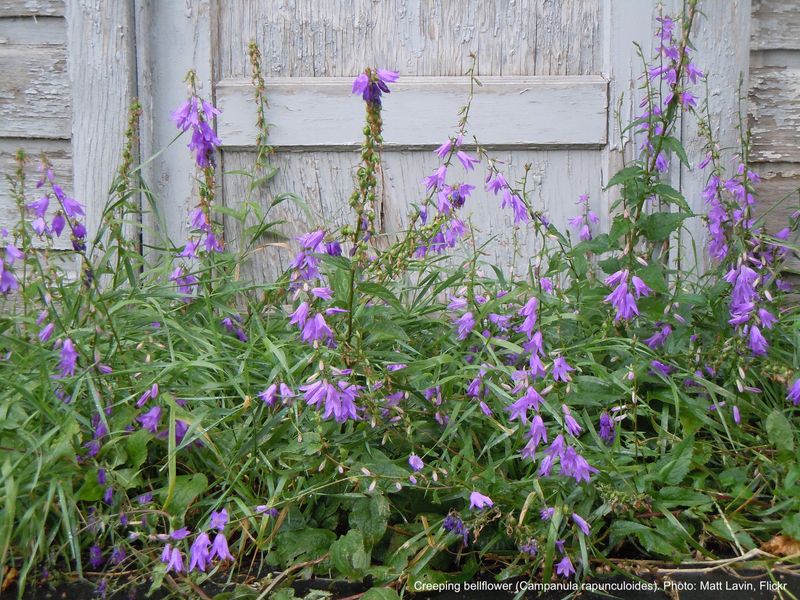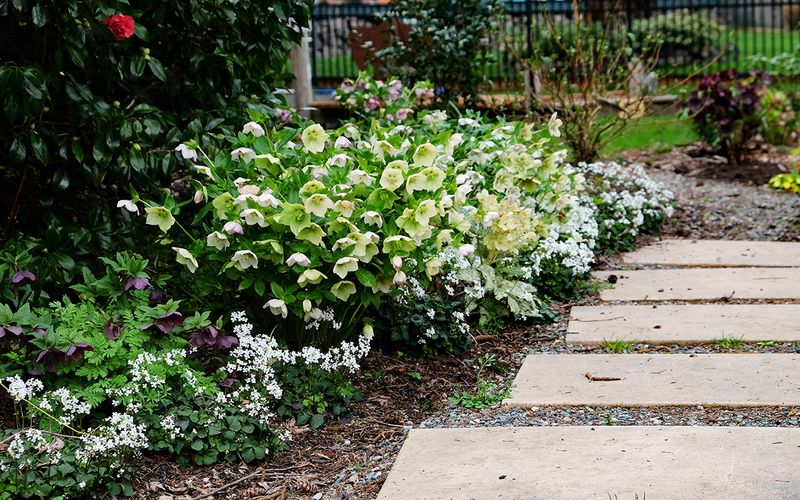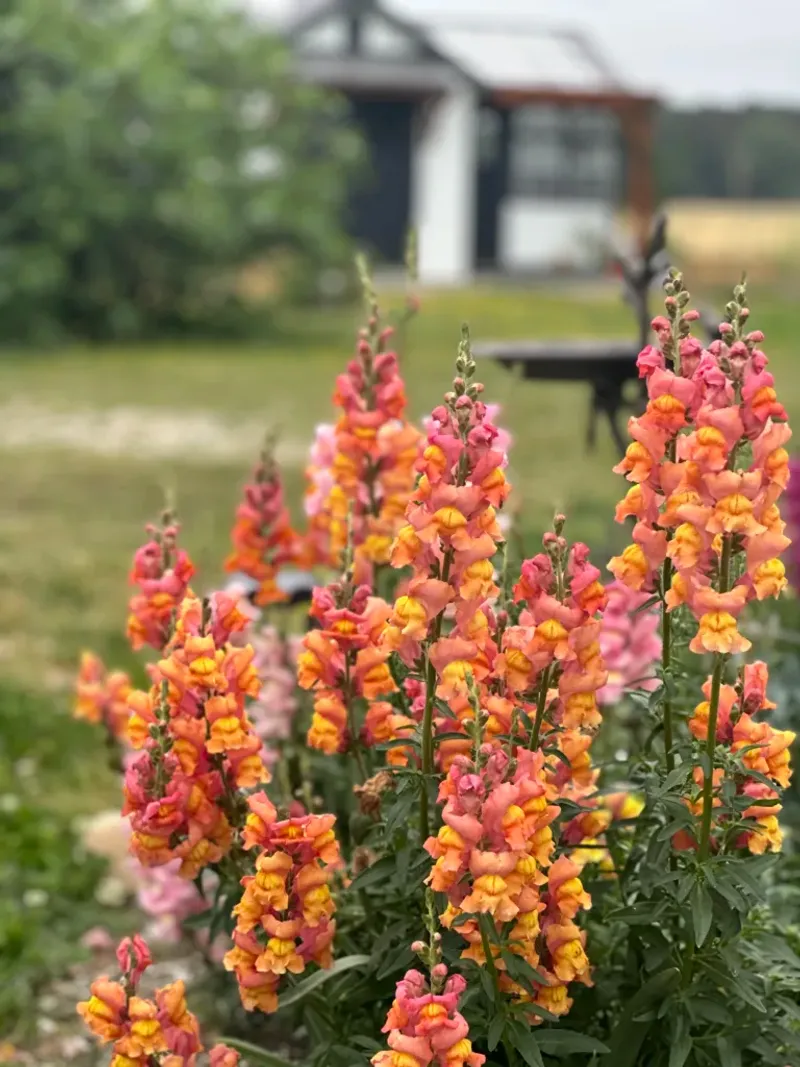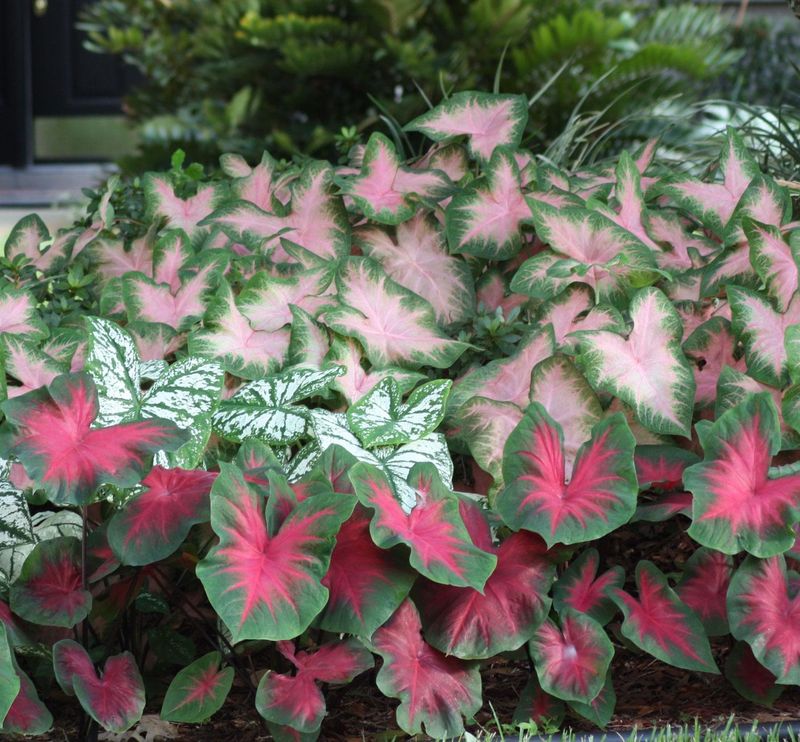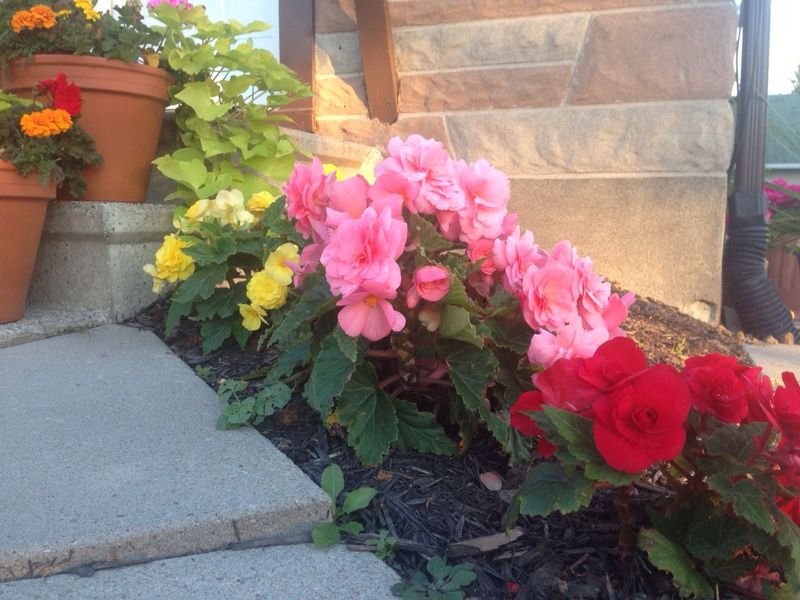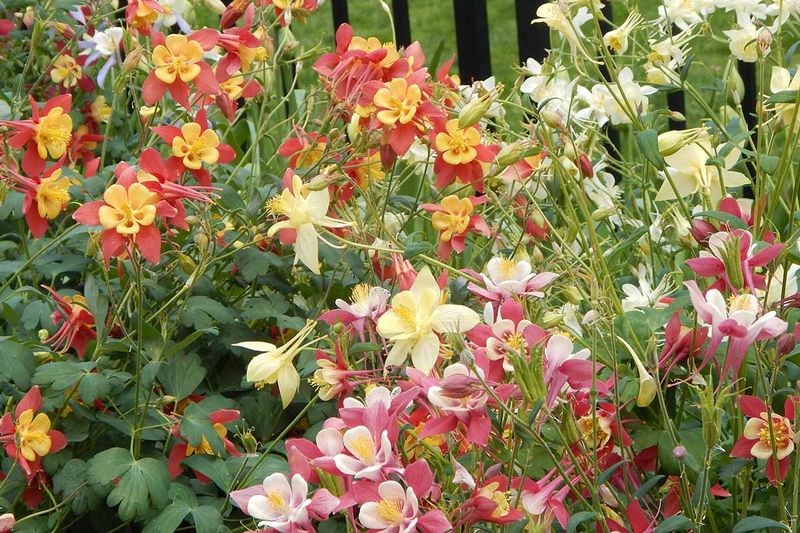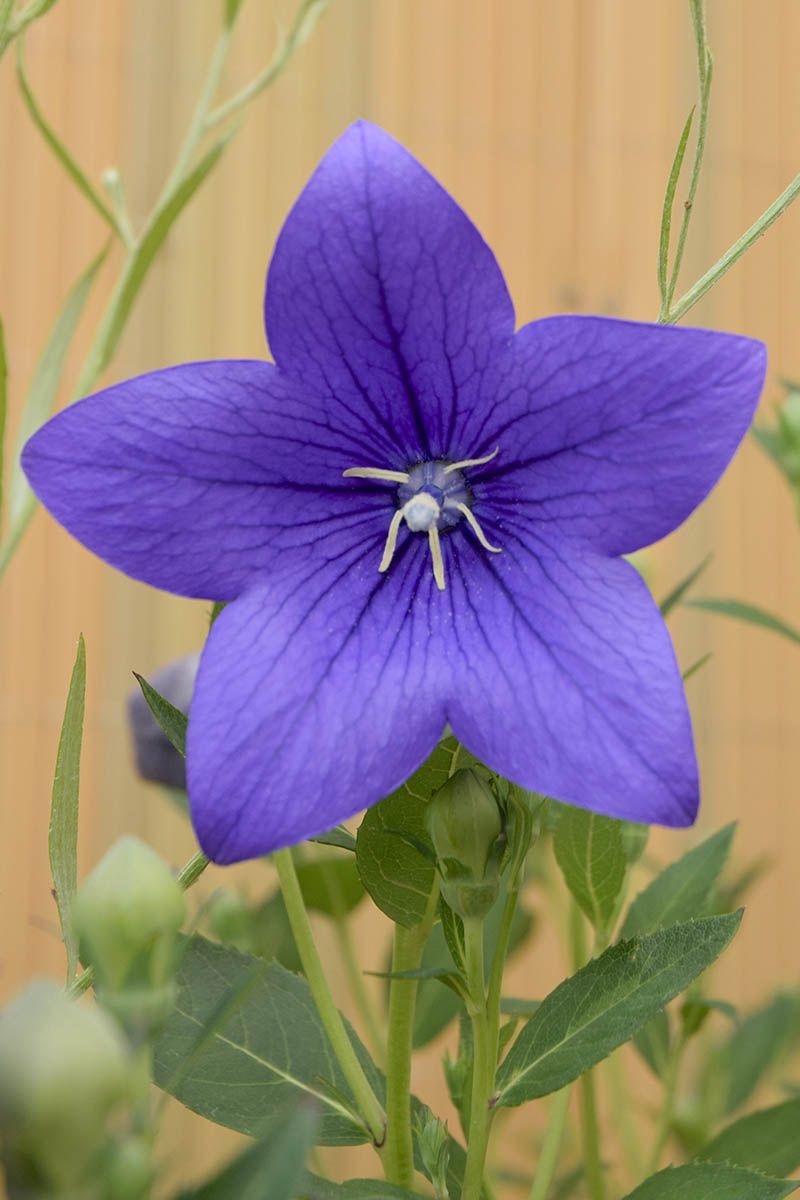Transform your garden pathways into enchanting landscapes with these 31 stunning plants, each offering unique beauty and charm.
Whether you’re after vibrant blooms or lush foliage, this collection provides perfect options to frame your walkways naturally. Discover how these plants can enrich your garden setting with color, texture, and fragrance.
1. Creeping Thyme
Creeping Thyme is a fragrant, low-growing plant ideal for adding charm to walkway borders. Its tiny purple flowers create a beautiful contrast against the lush green foliage as they cascade gently over the edges. This hardy plant thrives in well-drained soil and full sunlight.
Beyond its visual appeal, Creeping Thyme releases a lovely aroma when walked on, enhancing the sensory experience of your garden. It requires minimal maintenance, making it a favorite among gardeners. Plant it between stepping stones for a natural carpet effect that delights both sight and smell.
2. Dianthus (Pinks)
Dianthus, commonly known as Pinks, brings a splash of color with its charming, fragrant blooms. These flowers, in shades of pink, red, and white, feature delicate, fringed petals that add elegance to any border.
Their pleasing scent and vibrant hues make them irresistible to both people and pollinators. Plant them in well-drained soil and ensure they receive plenty of sunlight to flourish.
Dianthus not only enhances the visual appeal but also infuses the air with a sweet fragrance, creating a refreshing garden atmosphere. Their resilience and beauty make them a garden staple.
3. Sweet Alyssum
Sweet Alyssum forms a delicate carpet of tiny, honey-scented flowers that cover the ground in white, purple, or pink hues. Perfect for softening the edges of walkways, this plant brings a gentle fragrance that lingers in the air.
It’s a favorite among bees and butterflies, adding life and movement to your garden. Sweet Alyssum thrives in sunny locations with well-drained soil.
Its low-growing habit makes it an excellent choice for borders, as it weaves beautifully around stones and other plants, creating a seamless, natural look that invites admiration.
4. Coral Bells (Heuchera)
Coral Bells, known for their colorful foliage, offer a striking addition to walkway borders. With leaves in shades of deep burgundy, lime green, and silver, they provide year-round interest and texture.
Their small, bell-shaped flowers tower delicately above the foliage, attracting pollinators during blooming season. Plant them in partial shade with well-drained soil for optimal growth.
Coral Bells are highly versatile and can be used effectively in a variety of garden settings, from formal to rustic. Their ability to blend with other plants makes them a must-have for dynamic landscapes.
5. Liriope (Lilyturf)
Liriope, or Lilyturf, is admired for its tough, grass-like leaves and striking spikes of purple or white flowers. Ideal for lining pathways, it offers a neat, structured look that appeals to those seeking formal garden aesthetics.
Liriope is incredibly resilient, flourishing in a variety of soil types and light conditions. It’s also drought-tolerant, making it a practical choice for low-maintenance gardens.
As it blooms, the vibrant flower spikes add a touch of playfulness to its otherwise orderly appearance, making it an excellent choice for those wanting a balance of form and function.
6. Creeping Jenny
Creeping Jenny is a vibrant groundcover that brings a splash of golden-green to walkway borders. Its trailing habit allows it to spill gracefully over paths, softening hard edges with lush foliage.
This hardy plant thrives in moist, well-drained soil and can adapt to both sun and shade, making it versatile for various garden settings.
With minimal care required, Creeping Jenny is perfect for busy gardeners looking to create a lively and inviting garden atmosphere. It partners well with other plants, adding dimension and color to any border.
7. Bleeding Heart
Bleeding Heart is a captivating plant known for its delicate, heart-shaped flowers that dangle elegantly from arching stems. These charming blooms, usually in pink or white, add a romantic touch to any garden path.
Preferring shady, moist areas, Bleeding Heart thrives in woodland settings or shaded borders. Its lush green foliage remains attractive even after the flowers have faded.
This perennial brings early spring interest, and its unique blooms are a conversation starter. Pair it with ferns or other shade-loving plants for a lush, textured border that enchants visitors.
8. Rock Cress (Aubrieta)
Rock Cress, or Aubrieta, is a low-growing perennial renowned for its vibrant purple blooms. These flowers cascade beautifully over rocks and edges, making them ideal for adding a burst of color to walkway borders.
Rock Cress thrives in well-drained soil and sunny locations, spreading quickly to form a dense mat of foliage and flowers.
Its early spring blooms provide one of the first signs of color in the garden, attracting pollinators and delighting gardeners. Combine it with other rock garden plants for a layered, textured effect that impresses.
9. Sedum (Stonecrop)
Sedum, commonly known as Stonecrop, is a versatile plant with succulent-like, fleshy leaves and attractive clusters of flowers. Its late-season blooms in shades of pink, red, or yellow attract pollinators, adding life to garden borders.
Sedum thrives in sunny, well-drained locations and is highly drought-tolerant, making it perfect for low-maintenance gardens.
Its diverse forms and colors allow for creative planting combinations, whether used in rock gardens, borders, or containers. With its minimal care needs and vibrant presence, Sedum is a staple for gardeners looking to add texture and color.
10. Bee Balm (Monarda)
Bee Balm, or Monarda, is a magnet for bees and butterflies, thanks to its bright red, pink, or purple blossoms. These vibrant flowers add a lively, colorful touch to garden borders while supporting local pollinators.
Known for its aromatic foliage, Bee Balm thrives in sunny, well-drained areas and can tolerate poor soil. It’s not only visually stunning but also offers medicinal properties, making it a valuable addition to herb gardens.
Combine it with other sun-loving perennials to create a dynamic, wildlife-friendly garden that buzzes with activity.
11. Catmint (Nepeta)
Catmint, or Nepeta, is celebrated for its soft, silvery foliage and abundant lavender-blue flowers. These plants bring a relaxed, cottage-garden feel to walkway borders with their gentle colors and textures.
Catmint is highly resilient, thriving in full sun and well-drained soil while requiring little maintenance. Its fragrant leaves make it deer-resistant, and it attracts bees and butterflies.
This versatile plant pairs beautifully with roses and other perennials, adding a soft, flowing element to any garden design. Its long-lasting blooms and easy-care nature make it a gardener’s favorite.
12. Candytuft
Candytuft is an evergreen groundcover known for its bright white flowers that burst into bloom in early spring. These flowers create a dense, striking border that illuminates any garden path.
Ideal for sunny locations, Candytuft requires well-drained soil and regular watering during dry spells. It’s perfect for rock gardens, edging, and adding structure to borders.
Its evergreen foliage provides year-round interest, while the profusion of blooms attracts pollinators to your garden. Candytuft’s low, spreading habit makes it a versatile choice for filling gaps and creating visual continuity in garden designs.
13. Russian Sage
Russian Sage boasts tall, airy spikes of lavender-blue flowers complemented by silvery foliage. This plant creates a soft, dreamy look, perfect for adding height and texture to walkway borders.
It thrives in full sun and well-drained soil, and its drought-tolerant nature makes it suitable for xeriscaping. Russian Sage attracts pollinators, making it a valuable addition to wildlife gardens.
Its long blooming period and graceful appearance make it a favorite among gardeners looking to create a lush, yet low-maintenance landscape. Combine it with other drought-tolerant plants for a cohesive, resilient garden.
14. Foxglove
Foxglove is renowned for its tall, elegant spikes of bell-shaped flowers, typically in shades of pink, purple, or white. These striking blooms add height and drama to garden borders, creating a focal point that draws the eye.
Foxglove thrives in partial to full sun and prefers well-drained soil. Its blooms attract hummingbirds and bees, contributing to a vibrant garden ecosystem.
Caution is advised as all parts of the plant are toxic if ingested. Despite this, Foxglove’s towering beauty and cottage-garden charm make it a beloved choice for experienced gardeners.
15. Lamb’s Ear
Lamb’s Ear is adored for its velvety, silver-green foliage that creates a soft, touchable border along pathways. This plant’s unique texture and color add an element of intrigue and contrast to garden designs.
Thriving in full sun and well-drained soil, Lamb’s Ear is drought-tolerant and requires minimal maintenance. Its soft leaves make it a favorite for sensory gardens, inviting touch and interaction.
While its flowers are modest, the foliage shines as the main attraction. Pair Lamb’s Ear with bold, colorful plants to highlight its subtle beauty and enhance garden texture.
16. Phlox (Creeping & Tall Varieties)
Phlox offers a stunning display with clusters of flowers in pink, white, purple, or blue, creating a vibrant border that captivates the senses. Both creeping and tall varieties are valued for their long-lasting blooms and fragrant presence.
Creeping Phlox forms a dense mat ideal for low borders, while tall varieties add height and structure. Phlox thrives in well-drained soil with ample sunlight.
Their colorful blooms attract butterflies, enhancing the garden’s biodiversity. Phlox is versatile, pairing well with other perennials for a dynamic garden display that offers continuous interest throughout the growing season.
17. Yarrow
Yarrow is cherished for its flat-topped clusters of flowers in yellow, pink, or red, set against feathery, drought-resistant foliage. This hardy plant adds a touch of elegance to walkway borders and thrives in full sun.
Yarrow’s aromatic leaves are deer-resistant and attract beneficial insects, making it a great choice for eco-friendly gardens. Its long flowering season and ease of care make it a reliable option for garden enthusiasts.
Use Yarrow to add color and texture to borders, complementing other garden plants. Its adaptability and resilience make it a favorite in sustainable landscaping.
18. Shasta Daisy
Shasta Daisy brings timeless elegance to garden borders with its classic white blooms and bright yellow centers. These cheerful flowers create a sunny, welcoming atmosphere along pathways.
Shasta Daisy thrives in full sun and well-drained soil, requiring minimal care to flourish. Its long blooming season and resilience make it a staple in cottage and formal gardens alike.
This perennial attracts butterflies and makes excellent cut flowers, further extending its appeal beyond the garden. Combine Shasta Daisy with other sun-loving perennials for a harmonious and picturesque landscape.
19. Coreopsis (Tickseed)
Coreopsis, or Tickseed, offers cheerful, daisy-like flowers in shades of yellow, red, or pink, bringing warmth and vibrancy to garden borders. These hardy perennials are known for their long blooming period and low-maintenance nature.
Coreopsis thrives in full sun and well-drained soil, attracting butterflies and supporting pollinator habitats. Its tolerance to drought and poor soil conditions makes it a versatile choice for various garden settings.
The bright, sunny flowers pair well with other perennials, providing continuous color and interest. Coreopsis is ideal for gardeners seeking hardy, reliable blooms.
20. Salvia
Salvia is celebrated for its spiky, deep purple or blue flowers that attract bees and hummingbirds, adding dynamic movement to garden borders. These versatile perennials thrive in sunny locations with well-drained soil.
Salvia’s long blooming season and fragrant foliage make it a valuable addition to herb and flower gardens alike. It’s also deer-resistant, offering a practical choice for wildlife-friendly gardens.
Pair Salvia with other sun-loving perennials to create layered, colorful displays. Its striking blooms and easy-care nature make it a favorite for gardeners seeking beauty and resilience.
21. Ice Plant
Ice Plant is known for its low-growing, succulent foliage and dazzling neon pink, orange, or yellow daisy-like flowers. This plant creates a vivid carpet of color that brightens any walkway border.
Thriving in full sun and sandy, well-drained soil, Ice Plant is drought-tolerant and requires minimal maintenance. Its flowers open in sunlight, adding a dynamic element to garden designs.
Perfect for rock gardens and coastal landscapes, Ice Plant pairs well with other drought-tolerant species for a cohesive, vibrant look. Its bold colors and texture offer visual interest and delight.
22. Wallflowers
Wallflowers bring a burst of color and fragrance to garden borders with their clusters of orange, yellow, or purple blooms. These biennials are cherished for their sweet scent and vibrant presence in spring gardens.
Wallflowers thrive in sunny, well-drained locations and are perfect for mixed borders and cottage gardens. Their strong fragrance attracts bees and butterflies, enhancing garden biodiversity.
These versatile blooms pair well with spring bulbs and perennials, creating harmonious, layered displays. Wallflowers’ ability to flourish in poor soil conditions makes them a practical and charming choice for gardeners.
23. Dianella (Flax Lily)
Dianella, or Flax Lily, is admired for its strappy, blue-green leaves and tiny, star-shaped purple flowers. This plant adds structural interest and subtle color to garden borders.
Thriving in a variety of soil types and light conditions, Dianella is drought-tolerant and low-maintenance, making it ideal for busy gardeners. Its bright blue berries add additional seasonal interest.
Dianella’s architectural form pairs well with other foliage plants, contributing to a modern, textured landscape. Its adaptability and striking appearance make it a versatile choice for diverse garden settings.
24. Ajuga (Bugleweed)
Ajuga, or Bugleweed, offers a fast-spreading groundcover with deep purple leaves and spikes of blue flowers. This hardy plant forms dense carpets that suppress weeds and enrich garden borders.
Ajuga thrives in partial shade and moist, well-drained soil, making it perfect for shaded pathways and woodland gardens. Its colorful foliage provides year-round interest and complements a variety of plants.
Use Ajuga to create lush, textured borders that contrast beautifully with lighter-colored plants. Its vigorous growth and minimal care requirements make it a reliable choice for filling spaces and adding depth.
25. Campanula (Bellflower)
Campanula, or Bellflower, enchants with small, starry flowers in shades of blue or purple that bloom throughout the summer. These charming plants add a whimsical touch to garden borders with their cascading blooms.
Ideal for sunny to partially shaded areas, Campanula thrives in well-drained soil and rewards with long-lasting floral displays. Its flowers attract pollinators, supporting garden biodiversity.
Campanula’s delicate appearance pairs well with other perennials, creating romantic, layered garden designs. Its versatility and enduring beauty make it a beloved choice for gardeners seeking continuous bloom and charm.
26. Hellebores (Lenten Rose)
Hellebores, or Lenten Rose, offer early blooms with elegant, downward-facing flowers in white, pink, and deep purple. These perennials bring a touch of sophistication and color to garden borders at winter’s end.
Hellebores thrive in shaded, well-drained areas and are known for their resilience and long-lived nature. Their evergreen foliage provides year-round interest and complements other shade-loving plants.
Use Hellebores to add depth and texture to borders, creating lush, layered displays. Their subtle beauty and early flowering make them a cherished addition to any shade garden.
27. Snapdragon
Snapdragon captivates with its colorful, tall spikes of blooms that add a playful touch to garden borders. These charming flowers come in a rainbow of colors, creating lively displays along walkways.
Snapdragons thrive in sunny, well-drained conditions and bloom from spring to fall, attracting hummingbirds and butterflies. Their upright growth habit adds height and structure to garden designs.
Pair Snapdragons with other sun-loving annuals and perennials to create vibrant, layered displays. Their cheerful presence and long-lasting blooms make Snapdragons a delightful choice for gardeners seeking color and joy.
28. Caladium
Caladium is known for its tropical, heart-shaped leaves in vivid shades of pink, white, and green. These striking foliage plants create a bold, exotic look in shaded garden areas.
Caladium thrives in moist, well-drained soil and prefers partial to full shade. Its colorful leaves provide a lush, dramatic backdrop for other plants.
Use Caladium to add a touch of the tropics to your garden, pairing it with ferns and other shade-loving species. Its vibrant colors and distinctive shapes make it a standout choice for creating eye-catching, textured borders.
29. Begonias
Begonias are celebrated for their bright flowers and lush, waxy foliage, thriving in both sun and shade. These versatile plants bring color and texture to garden borders, enhancing shaded areas with their vivid blooms.
With a variety of forms, including tuberous and fibrous types, Begonias offer endless possibilities for garden designs. Their preference for well-drained, moist soil and partial shade makes them easy to care for.
Combine Begonias with other shade-tolerant plants for a dynamic, colorful display. Their adaptability and beauty make them a favorite among gardeners looking to brighten their gardens.
30. Columbine
Columbine enchants with its delicate, spurred flowers that come in a variety of colors. These whimsical blooms attract hummingbirds, adding life and movement to garden borders.
Columbine thrives in well-drained soil and partial to full sun, making it suitable for diverse garden settings. Its charming flowers and attractive foliage provide visual interest throughout the growing season.
Use Columbine to complement other perennials in cottage or woodland gardens, creating layered, enchanting displays. Their unique shape and vibrant colors make Columbine a beloved choice for adding elegance and wildlife interest.
31. Balloon Flower
Balloon Flower captivates with its puffy, balloon-like buds that burst open into star-shaped flowers in blue, pink, or white. These unique blooms add a playful and unexpected element to garden borders.
Balloon Flowers thrive in sunny, well-drained locations and require minimal maintenance, making them ideal for busy gardeners. Their long-lasting blooms and distinctive shape attract attention and delight visitors.
Pair them with other perennials for a layered, dynamic garden design. Their whimsical presence and ease of care make Balloon Flowers a favorite for gardeners seeking charm and personality.
